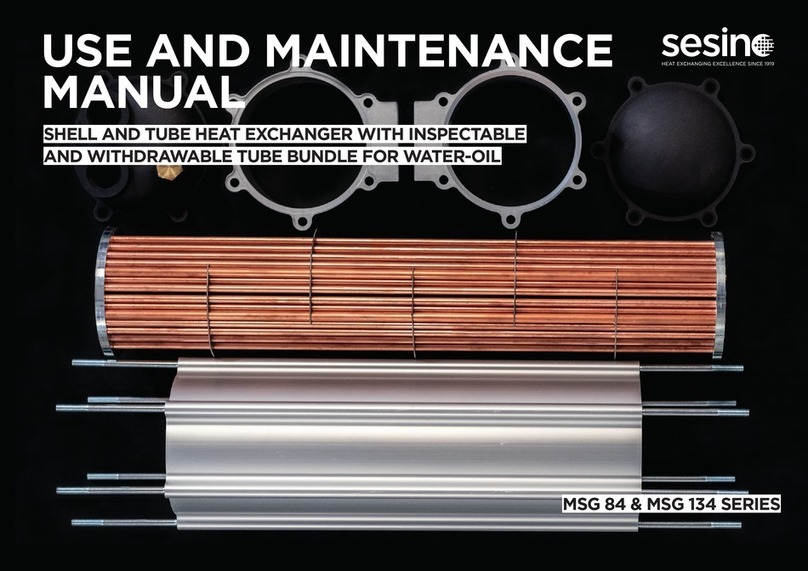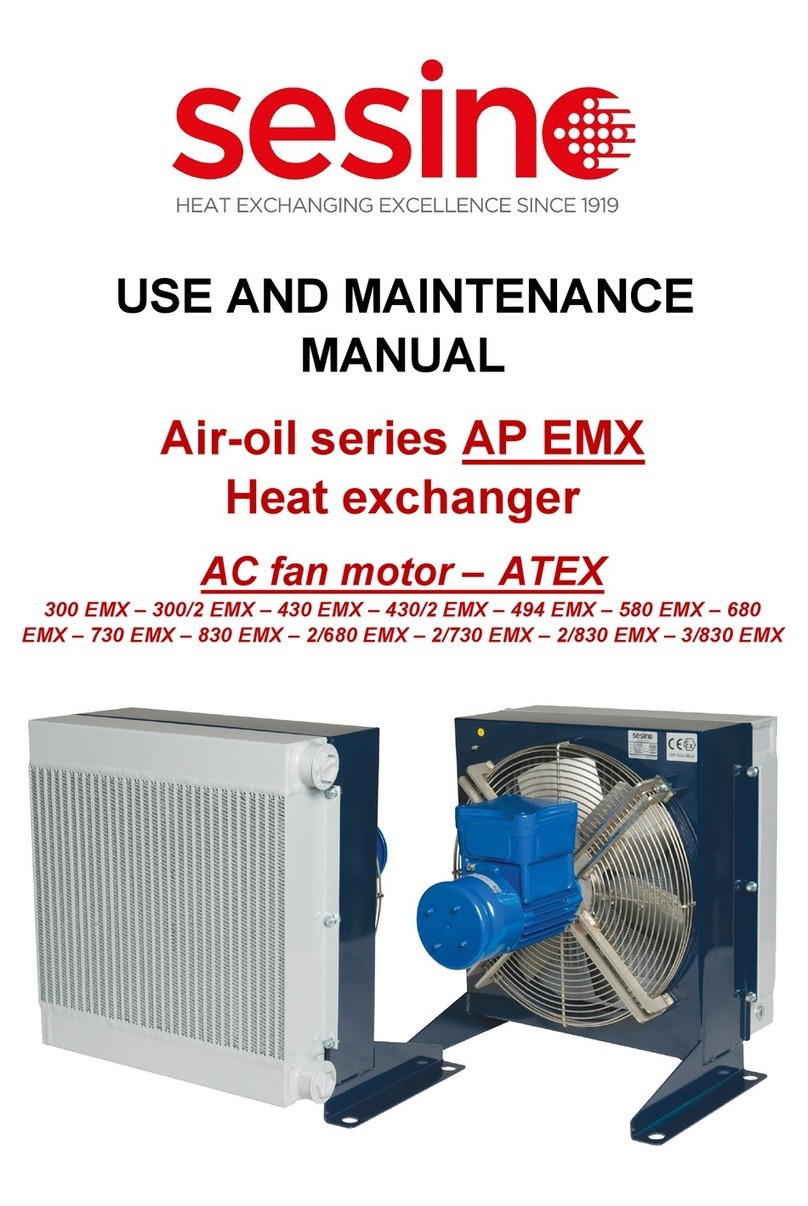Sesino M Series User manual

USE AND MAINTENANCE
MANUAL
Water-oil series M
Brazed plates
Heat exchanger
M 18 – 25 – 55

USE AND MAINTENANCE
MANUAL
Water-oil series M
Heat exchanger
Brazed plates
2
INDEX
1. INTRODUCTION.................................................................................... 3
2. WARNINGS............................................................................................ 3
3. ASSEMBLY AND INSTALLATION ......................................................... 4
4. TECHNICAL SPECIFICATIONS OF USE .............................................. 6
5. PERIODIC MAINTENANCE ................................................................... 7
6. TAMPERING .......................................................................................... 8
7. STORAGE.............................................................................................. 8
8. DISPOSAL ............................................................................................. 8

USE AND MAINTENANCE
MANUAL
Water-oil series M
Heat exchanger
Brazed plates
3
1. INTRODUCTION
This manual should be considered an integral part of the heat exchanger and should be
kept with it.
Keep this manual intact and available for the whole product life.
Carefully read the manual before installation of the heat exchanger.
The manual contains important information about safety.
2. WARNINGS
a) The heat exchanger has to be used only for that which it was designed. Any other
use may cause damage to property and people, and therefore the manufacturer
declines all responsibility for accidents arising from its misuse.
a) The heat exchanger must be used for the operating conditions (pressure and
temperature) and for the fluid for which it was thermally and mechanically designed
and for which it was evaluated the chemical compatibility. In the event of operating
conditions other than those calculated the heat exchanger performance change and
very serious damage to the unit might occur.
b) The pressures and flow rates of the fluids must be taken within the design limits to
prevent vibration, erosion and in some cases breakage of the most stressed parts by
the fluid dynamic action.
c) Before connecting the two supplies to the system verify that the hydraulic circuit
meets the performance of the heat exchanger.

USE AND MAINTENANCE
MANUAL
Water-oil series M
Heat exchanger
Brazed plates
4
d) Do not touch the heat exchanger while it is running. During operation, some external
surfaces may be hot.
e) Do not remove the nameplate of the heat exchanger. It reports the product
specifications and contractual references that allow the traceability of the same. It is
considered an integral part of the heat exchanger and should remain clearly visible
on it.
3. ASSEMBLY AND INSTALLATION
Brazed plate heat exchangers consist of a pack of embossed steel plates which are
brazed together by copper or nickel in a furnace. There are two separate flow channels or
pressure channels (primary and secondary side) with the two fluids in counter current.
Brazed plate heat exchangers should be mounted so there is sufficient room around the
them to perform maintenance work. The fitting position is to be chosen in such a way that
venting and draining of the heat exchanger are possible.
Vertical position of the exchanger is the most efficient one; all other fitting positions can
lead to power loss.
Never mount the heat exchanger with the connections pointing down. Preferably, the heat
exchanger should be supported by a bracket or support. The unit should not be supported
solely by the piping.
The maximum connecting forces and torques are not to be exceeded.
In most applications the highest efficiency is realized by connecting the heat exchanger for
counter-current flow. The primary side of the heat exchanger is identified by an orange
label. The primary channels are the inner channels. The first and last channel is always on
the secondary side.
Warning: On new or renovated systems, flushing the piping to remove construction debris
is recommended before connecting the piping to the heat exchanger. A mesh size of 0,8
mm (closed circuits) and 0,08 mm (open circuits) will retain any particle. The strainer must
be located at the inlet to the heat exchanger.
The water-oil heat exchanger are generally fixed in the return circuit. It is also possible to
carry out a separate circuit through a self-contained pump. This is recommended when the

USE AND MAINTENANCE
MANUAL
Water-oil series M
Heat exchanger
Brazed plates
5
outlet oil rates are variable. In this way, it is possible to obtain a better thermal
performance.
In the hydraulic systems it is possible the occurrence of pressure peaks (fluid hammers)
that could approach or exceed the maximum allowable pressure of the exchanger. In this
case, it is recommended to supply it with a self-contained pump.
Warning: These pulsations move inside the oil at the sound velocity, therefore they cannot
be gauged with standard manometers, but only with a proper electronic instrumentation.
Warning: Insure that severe vibrations or pulsations cannot be transmitted to the heat
exchanger by installing vibration absorbers in the piping and using vibration absorbing
material between the heat exchanger and the equipment. Service life of the heat
exchangers is markedly reduced by incorrect or inadequate automatic control. There are
some factors which have a detrimental effect on the service life. This facts should be
avoided:
•oversized regulating valves;
•excessive variations in system differential pressures;
•regulating valves of poor quality;
•incorrect regulator settings;
•incorrect sensors placing.
Make sure to install the heat exchanger through its supports on suitable supports to hold
the weight.

USE AND MAINTENANCE
MANUAL
Water-oil series M
Heat exchanger
Brazed plates
6
4. TECHNICAL SPECIFICATIONS OF USE
•Hot fluid inlet max. temperature: 225°C
•Cold fluid inlet min. temperature: -160°C
•Operating fluids:
Mineral oil
Synthetic oil
Emulsified water
Water- Ethylene glycol
•Maximum allowable operating pressure: 30 bar
N.B.: please contact our Technical Department in case of special applications.
When the system on which it is installed is fully operational, you should check if the
amount of the water flowing through the heat exchanger is correct. This can be done
easily by controlling its thermal gradient that should not be too low (too high flow rate),
neither too high (low flow rate).
It is good practice to consider a temperature difference of 10°C when the inlet water
temperature is 20°C and a temperature difference of 5°C with higher water temperatures.
It is also advisable to avoid that the water remains completely still within the heat
exchanger because, when its temperature exceeds 50°C, the limestone contained in it
starts to sediment significantly reducing quickly the opening of the channels.
Before putting the device into operation it has to be checked to ensure that the operation
data shown on the nameplate are not exceeded.
Check the tightness of the screw connections.
The pumps feeding the heat exchanger must be equipped with shut-off valves. Pumps
which generate higher pressures than stated for the device must be fitted with safety
valves. The pumps must not aspirate any air so that no disruptions of operation due to
water hammer occur. In order to avoid pressure surges, the pumps are to be started up
against closed valves. The valves in the supply and return lines are to be opened slowly
and, as far as possible, simultaneously, until the service temperature is reached. Pressure
surges are to be avoided. During filling the device is to be vented via the vent valves
located in the piping.
Warning: Shutdown must be effected slowly and simultaneously for both sides (primary
and secondary sides). If this is not possible, the hot side is to be shutdown first. For a long
downtime of the heat exchanger is to be completely drained and cleaned. This applies in
particular when there is a danger of frost, in the case of aggressive fluids and fluids which
have a biological fouling tendency.
After the device has been put into service it is to be checked to ensure that no pressure
pulsations are acting on the device.

USE AND MAINTENANCE
MANUAL
Water-oil series M
Heat exchanger
Brazed plates
7
It is generally to be ensured that no operating conditions can arise which are contradictory
to these assembly, operating and maintenance instructions.
Warning: Water hammers, pressure and temperature cycles can lead to leaks in the heat
exchanger.
5. PERIODIC MAINTENANCE
It is needed to disassemble the exchanger from the system for cleaning purposes.
During shutdown of the unit it is be ensured that first the primary side (hot side) and then
the secondary side (cold side) is closed. Vice versa during start-up first the secondary side
and then the primary side is opened. In that way overheating of the heat exchanger is
avoided.
Warning: Do not try to dismount the exchanger without having depressurized, drained and
cooled to ambient temperature the unit.
Many different factors can influence fouling. These are, for example, velocity, temperature,
turbulence, fluid quality. In some applications, the fouling tendency may be high, for
example, when using very hard water.
The fluids are to be moved at the highest possible mass flows. In the event of excessively
low mass flows (part load) the turbulence in the heat exchanger decreases causing the
increase of the fouling tendency.
Lime deposits in the heat exchanger can be possible at temperatures above 50°C.
Turbulent flow and lower temperatures reduce the risk of calcification.
It is recommended to check the exchanger every 2 or 3 months to avoid that calcareous
sediments completely close the channels inside which water flows.
It is always possible to clean the heat exchanger by circulating a detergent liquid (CIP)
inside it; it is recommended to use a tank containing weak acid, 5% nitric or phosphoric
acid or, in case the heat exchanger is subject to frequent cleaning, 5% oxalic acid.
Warning: Care should be taken when using chemical cleaning fluids. Carefully follow the
manufacturer's instructions and use systems of protection for the skin and eyes. When
required use a respirator.
Let the detergent circulate inside the exchanger: for an effective cleaning the detergent
flow rate must be at least equal to 1,5 times the normal working one, preferably in reverse
circulation mode.
Rinse thoroughly with water in order to remove all traces of acid before putting the system
into operation. The use of a solution of 1-2% sodium hydroxide or sodium bicarbonate
before the last rinse ensures the complete neutralization of the acid.
Perform this cleaning at regular intervals.
During this operation, Costante Sesino S.p.A. recommend to comply with the anti-pollution
standards and to use the appropriate services for the collection of waste oil.

USE AND MAINTENANCE
MANUAL
Water-oil series M
Heat exchanger
Brazed plates
8
The use of a filter is recommendable if it is assumed that particles with size of more than 1
mm may be present in the fluid; sizes smaller than 1 mm do not cause any malfunction.
6. TAMPERING
Any operation aimed to modify the heat exchanger, executed without prior authorization
from the Constante Sesino S.p.A. will automatically result in the decline of the warranty
provisions.
7. STORAGE
The heat exchanger has to be stored in a moisture free environment (<60%) and at a
temperature (from 5 ° C to 30 ° C) such as to prevent condensation and oxidation to its
internal parts.
8. DISPOSAL
The Costante Sesino S.p.A. heat exchangers are manufactured with fully recyclable
materials.
Therefore they are disposable without any harm to the environment according to the rules
and regulations in the area of use.
COSTANTE SESINO SPA
Heat exchangers
www.sesino.com
Via Monza 150A/B, 20060 Gessate – Milano (Italy)
Tel. +39.02.95.38.03.34
Fax +39.02.95.78.05.28
This manual suits for next models
3
Table of contents
Other Sesino Industrial Equipment manuals



















